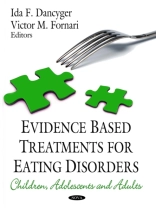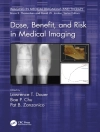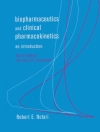What does the evidence suggest is the most effective treatment for an individual with Anorexia Nervosa? What treatment is effective for someone with Bulimia Nervosa? Is there data to support the treatment of Binge Eating Disorder? Is there any evidence to support what treatment will be effective for Obesity? These important considerations will be reviewed in this current and comprehensive review of the exisiting evidence-based practices. This will serve as a resource for individuals with an eating disorder, their families, practioners, students in nutrition, psychology, social work and psychiatry, as well as the general public. Anorexia Nervorsa, Bulima Nervosa, Binge Eating Disorder and Obesity are prevalent public health concerns that cause significant morbidity and mortality. As the scientific literature accumulates a body of information regarding these clinical problems, this book serves as an invaluable reference providing a summary of the current evidence in the literature. "Given the many behavioral complexities of eating disorders and widely varying accounts of their essential nature, it is hardly surprising that the skills required for balanced understanding and effective management of these puzzling conditions are similarly diverse. The value of this well-written and comprehensive text owes to its internationally-recognized group of contributors who lay out important strands of research alongside specific modalities of treatment. The detail each chapter contains will surely appeal to readers in each of the clinical disciplines that confront the everyday challenge these patients present." (Michael Strober, David Geffen School of Medicine at Univ. of California, Los Angeles, ED., Int. Journal of Eating Disorders) The latest Academy for Eating Disorders Forum – Book Review Section offers a review of our book. Book Review Corner Angela Celio Doyle, Ph D Evidence-Based Treatments for Eating Disorders: Children, Adolescents and Adults Edited by Ida F. Dancyger and Victor M. Fornari 19 Chapters The experience of reading "Evidence-Based Treatments for Eating Disorders" is similar to that of arriving at the annual International Conference on Eating Disorders (ICED) on the first day. You are provided with a thought-provoking introduction and are then quickly drawn into an exciting review of the state of the science of eating disorders treatment as presented by leading experts from all over the world. Indeed, one might consider "Evidence-Based Treatments for Eating Disorders" to be a print version of an ICED’s highlights. The intended audience for this book is clinicians of all experience levels seeking guidance on the best practices for the treatment of eating disorders and obesity. The 19 chapters unite to create a primer on the major approaches to the treatment of eating disorders and obesity, with a particular focus on outpatient treatment. Similar to an ICED, this compendium strives to create, as Walter Vandereycken describes in the foreword, a "fruitful merging of an evidence-based and an experience-based approach." As the title implies, the emphasis of "Evidence-Based Treatments for Eating Disorders" is on evidence-based or evidence-informed treatments. However, some chapters include descriptions of promising treatments supported by a smaller number of controlled studies. The opening three chapters of "Evidence-Based Treatments for Eating Disorders" provide an overview of the etiological underpinnings of anorexia nervosa (AN), bulimia nervosa (BN), binge eating disorder (BED), and obesity. Chapter 4 skillfully addresses the gap between research and practice and describes the efforts of the AED to bring the expertise of clinicians and researchers together. Inpatient treatment and day programs for eating disorders (EDs) are reviewed in Chapters 5 and 6, respectively. Chapter 7 reviews consensus statements on medical and nutritional care in the treatment of EDs and addresses some of the principles that frequently garner discussion within treatment teams, such as determining an optimal goal weight for patients with EDs. A chapter on children (Chapter 8) describes unique aspects of symptom presentation in younger individuals with EDs and outlines best-practice treatments for this group. A chapter on males (Chapter 9) is particularly helpful in its review of differences in symptoms and treatment outcomes for males versus females. The authors also present male-specific adaptations to the traditional CBT approaches for BN based on their experience. The difficult issues of ambivalence and resistance to treatment in eating disorders are taken on in Chapter 10, including refusal to consent to treatment in AN. The authors provide practical guidance in their "rational approach" to dealing with treatment resistance. Beginning with Chapter 11, the book shifts in focus towards specific treatments applied to certain ED populations. Chapter 11 provides an overview of the state of the science in treating adults with AN and presents the CBT model for weight-restored adults with AN. CBT is described in more detail in Chapter 12 in its application to adults with BN, as well as the scientific evidence supporting this approach. Evidence-based treatments for obesity and BED, including behavioral therapy, pharmacological interventions, and novel treatment approaches are reviewed in Chapter 13. The breadth of this topic results in less detail on specific interventions, but still provides a helpful roadmap to navigating the treatment of obesity and BED. Chapter 14 is devoted to providing a primer on the use of Interpersonal Psychotherapy (IPT) for BN and BED, and Chapter 15 covers DBT-enhanced CBT for ED, which is suggested as a particularly useful option in treating non-responsive individuals and complicated cases. Chapter 16 provides an excellent snapshot of the development of Family-based Treatment (FBT) for adolescents with AN, including an overview of its administration and modifications designed to facilitate its use in the treatment of adolescents with BN. A more recent addition to the major modalities of ED treatment, Integrative Cognitive-Affective Therapy (ICAT), is presented in Chapter 17. This chapter provides an excellent introduction to ICAT, describes novel aspects of the treatment, such as the use of a Palmtop computer to assist in identifying emotional states, and includes transcripts from prototypical sessions. Psychopharmacological best-practices in the treatment of AN and BN are reviewed in Chapters 18 and 19, respectively. The tables in these chapters provide a quick reference to findings from medication studies, and case examples provide illustrations of the ways in which pharmacology is integrated into psychological treatments. Some of the chapters in "Evidence-Based Treatments for Eating Disorders" are more conclusive than others based on the advances in our understanding in that particular topic area, but all are of excellent quality and will provide clinicians with a solid starting point for treatment. Clinicians of all backgrounds will find this book to be an essential addition to their treatment libraries.
Ida Dancyger & Victor Fornar
Evidence Based Treatments for Eating Disorders [PDF ebook]
Children, Adolescents and Adults
Evidence Based Treatments for Eating Disorders [PDF ebook]
Children, Adolescents and Adults
Compre este e-book e ganhe mais 1 GRÁTIS!
Formato PDF ● Páginas 409 ● ISBN 9781633210219 ● Editor Ida Dancyger & Victor Fornar ● Editora Nova Science Publishers ● Publicado 2014 ● Carregável 3 vezes ● Moeda EUR ● ID 7224502 ● Proteção contra cópia Adobe DRM
Requer um leitor de ebook capaz de DRM












